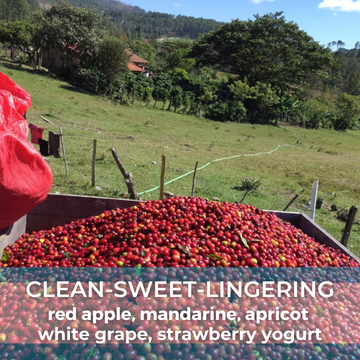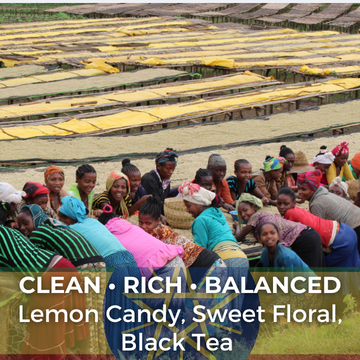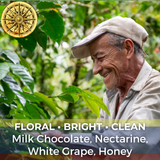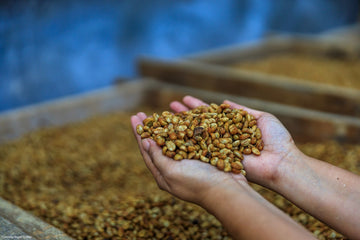Guatemala Blue Ayarza Natural
The region of Ayarza is a special one, landmarked by the drastic landscape and cold blue water from the Laguna de Ayarza and Laguna Azul. The lake was formed by two massive volcanos that collapsed and formed a large crater. The legends surrounding this lake are numerous like the one that says the bottom has never been found. There is a large white rock that resembles a petrified woman who didn’t follow the orders of Jesus. In short, there are simply too many good stories about Ayarza to do it justice!
Covoya Guatemala always knew the region had massive potential to produce specialty coffee, but the cups that we found were usually solid but unsurprising. Four years ago we rented a wet mill at 1,500 meters on a RFA certified farm. The quality coming from our washed coffee was much better than we expected. Next we tried the honey and meceration processes.
For natural-processed coffees under the Blue Ayarza mark, the best cherries from small holders in the region deliver to our mill, often in their own pickup trucks. Cherry is sent to Amatitilan for drying, the coffee starts for 10 days on the patio. To finish the coffee is mechanically dried for 5-10 hours.
The region of Ayarza is a special one, landmarked by the drastic landscape and cold blue water from the Laguna de Ayarza and Laguna Azul. The lake was formed by two massive volcanos that collapsed and formed a large crater. The legends surrounding this lake are numerous like the one that says the bottom has never been found. There is a large white rock that resembles a petrified woman who didn’t follow the orders of Jesus. In short, there are simply too many good stories about Ayarza to do it justice!
Covoya Guatemala always knew the region had massive potential to produce specialty coffee, but the cups that we found were usually solid but unsurprising. Four years ago we rented a wet mill at 1,500 meters on a RFA certified farm. The quality coming from our washed coffee was much better than we expected. Next we tried the honey and meceration processes.
For natural-processed coffees under the Blue Ayarza mark, the best cherries from small holders in the region deliver to our mill, often in their own pickup trucks. Cherry is sent to Amatitilan for drying, the coffee starts for 10 days on the patio. To finish the coffee is mechanically dried for 5-10 hours.
Reminder! This coffee is raw, you must roast it before brewing
Harvest Season: 2024-2025
Acidity & Brightness: Refreshingly bright and sweet.
Balance & Finish: Slightly complex with a lingering, pleasant finish
Body & Texture: Full body and creamy texture
Flavors: Fresh raspberry, blackberry, limeaid, cane syrup and florals
Grade: SHB EP, grown at 1,300 – 2,000 masl
Processing: Natural (dry) processed and dried on patios
Grower: Smallholder farms
Region: Santa Rosa, Guatemala
Varieties: Bourbon, Anacafe 14, Catuai, Pache
Recommended Roast Range: City+ to Full City+ (light-medium to medium-dark)
We like this coffee best at a light-medium roast or as 1st crack is trailing off. At that roast level we noted the best balance between the sweet fruit and berry notes along with refreshing acidity and rich caramels. Take your roast darker into Full Medium (after 1st crack ends but before 2nd crack begins) if you want to lower the acidity and bring out more body and rich caramel. Take it as dark as the first few snaps of 2nd crack, but expect to lose much of the subtle fruit notes in exchange for more toffee and candy notes.
COVOYA - Growing Coffee in Guatemala Coffee farming practices are similar to other countries in the region, but Guatemala has an abundance of water, volcanic soil, and very distinct micro-climates compared to its neighbors. Although late to coffee, Guatemala recognized and responded to the needs of the emerging specialty coffee sector earlier than most coffee-producing regions. Anacafé, the coffee producers association in Guatemala, identifies seven growing regions: Fraijanes, the plateau south of Guatemala City; Coban, a rainforest region in the center of the country; Huehuetenango, highlands near the border with Mexico; Atitlan, primarily the volcanic mountains on the Pacific side of Lake Atitlan; San Marcos, between Huehuetenango and the Pacific Ocean; Oriente, the driest of the growing regions located near the eastern border with Honduras; and the most famous of all, Antigua, nestled among the volcanoes an hour’s drive southwest of Guatemala City.


















